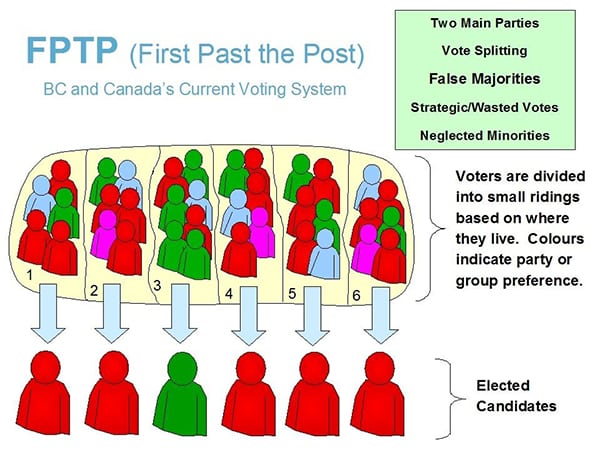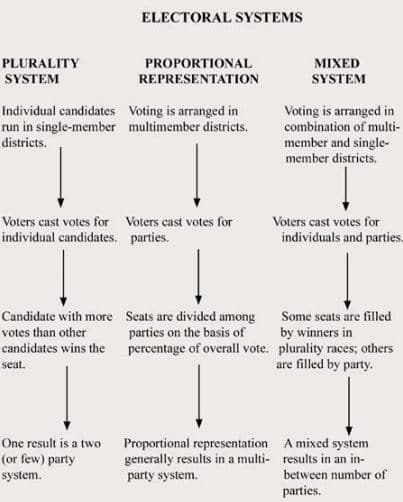Linkage Institutions
- In many countries we may identify groups that connect the government to its citizens, such as political parties, interest groups, and print and electronic media as linkage institutions.
- Their size and development depends partly on the size of the population, and partly on the scope of government activity.
- The larger the population and the more complex the government’s policymaking activities, the more likely the country is to have well developed linkage institutions.
-
-

.
-
Parties
- The array of political parties operating in a particular country and the nature of the relationships among them is called a party system.
- Political parties perform many functions in democracies.
- First, they help bring different people and ideas together to establish the means by which the majority can rule.
- Second, they provide labels for candidates that help citizens decide how to vote.
- Third, they hold politicians accountable to the electorate and other political elites.
- Most democracies have multi-party systems, with the two-party system in the United Kingdom being a more unusual arrangement.
- Communist states have one-party systems that dominate the governments like China, but non-communist countries have also had one-party systems like Mexico before 2000.
- An example is Mexico during most of the 20th century when it was dominated by PRI.
- Russia after the fall of communism in 1991, has shifted from one-party system to dominant party system as United Russia has been controlling the regime since 2000.
- The two-party system is a rarity, occurring in only about 15 countries in the world today.
- The United Kingdom has had two major political parties – the Conservatives and the Labours – throughout the last century
- Although minor parties do exist, historically those two parties have had the only reasonable chance to win national elections.
- The most important single reason for the existence of a two-party system is the plurality electoral system.
- Most European countries today have multi-party systems.
- They usually arise in countries with strong parliamentary systems, particularly those that use a proportional representation method for elections.
-
-

.
-
Electoral Systems and Elections
- Electoral systems are the rules that decide how votes are cast, counted, and translated into seats in a legislature.
- All democracies divide their populations by electoral boundaries, but they use many different arrangements.
- The United States, India, and Great Britain use a system called first-past-the-post, in which they divide their constituencies into single-member districts in which candidates compete for a single representative’s seat.
- It is also called the plurality system, or the winner-take-all system, because the winner does not need a majority to win, but simply must get more votes than anyone else.

- In contrast, many countries use proportional representation that creates multi-member districts in which more than one legislative seat is contested in each district.
- Under proportional representation, voters cast their ballots for a party rather than for a candidate, and the percentage of votes a party receives determines how many seats the party will gain in the legislature.

- South Africa and Italy use a system based solely on proportional representation.
- Many countries, including Germany, Mexico, and Russia, have used a mixed system that combines first-past-the-post and proportional representation.
- Russia currently uses a mixed electoral system for its national parliamentary (State Duma) elections, half by FPTP and half by PR with 5% threshold.
- For example, in Mexico, 300 of the 500 members of the Chamber of Deputies (the lower house) are elected through the winner-take-all system from single-member districts, and 200 members are selected by proportional representation.
- Plurality systems encourage large, broad-based parties because no matter how many people run in a district, the person with the largest number of votes wins.
- This encourages parties to become larger, spreading their “umbrellas” to embrace more voters.
- Parties without big groups of voters supporting them have little hope of winning, and often even have a hard time getting their candidates listed on the ballot.
- In contrast, the proportional representation electoral system encourages multiple parties because they have a good chance of getting some of their candidates elected.
- This system allows minor parties to form coalitions to create a majority vote so that legislation can be passed.
- Democracies also vary in the types of elections that they hold.
- A basic distinction between a presidential and parliamentary system is that the president is directly elected by the people to the position, and the prime minister is elected as a member of the legislature.
- The prime minister becomes head of government because (s)he is the leader of his or her party or coalition.


In general, these types of elections are found in democracies:
A) Election of public officials –
- The number of elected officials varies widely, with thousands of officials elected in the United
States, and far fewer in most other democracies. - However, even in a unitary state, many local and regional officials are directly elected. Legislators are often directly elected, both on the regional and national levels.
- Now citizens of many European countries also elect representatives to the European Union’s Parliament.
- Lower houses are more likely to be directly elected than upper houses, with a variety of techniques used for the latter.
B) Referendum –
- Besides elections to choose public officials, many countries also have the option of allowing public votes on particular policy issues.
- A ballot called by the government on a policy issue is called a referendum. Such votes allow the public to make direct decisions about policy itself such as the Brexit in Britain.
- Referenda exist only on the state and local level in the United States and Canada, but many other countries have used them nationally.
- The French and Russian presidents have the power to call referenda, and they have sometimes had important political consequences.
- For example, when a referendum proposed by French President Charles De Gaulle failed, he resigned his office in reaction to the snub by the voters.
- In Russia, the Constitution of 1993 was presented as a referendum for approval by the voters.
- In Britain, devolution of powers to the Scottish and Welsh parliaments was put before the voters in those regions in the form of referenda.
- The European Constitution failed because it was voted down in referenda in the Netherlands and France.
- A variation of a referendum is a plebiscite, or a ballot to consult public opinion in a nonbinding way.
C) Initiative –
- Whereas referenda are called by the government, an initiative is a vote on a policy that is initiated by the people.
- Although less common than the referendum, the initiative must propose an issue for a nationwide vote and its organizers must collect a certain number of supporting signatures from the public.
- The government is then obliged to schedule a vote.
-

.
Difference Between Social Capital and Political Efficacy
- Both social capital and political efficacy are essential for political participation and democracy, but they focus on different aspects of citizen engagement.
- Social capital is about collective political engagement through networks and trust in society.
- Political efficacy is about an individual’s belief in their ability to impact politics.
- Both concepts are crucial—high social capital can boost political efficacy, as engaged communities often empower individuals to participate in democracy.

Key Takeaways
- Linkage Institutions serve as essential connections between people and government.
- Political Parties organize competition for power and help structure political debate; party systems vary (one-party, two-party, multi-party).
- Electoral Systems greatly influence how votes translate into seats and thus shape party systems (FPTP → 2-party lean; PR → multi-party).
- Types of Elections (public officials, referendums, initiatives) offer different avenues for citizen input and can differ widely across democracies.
